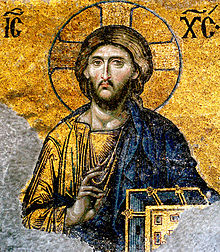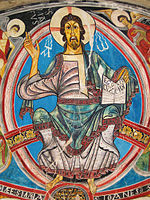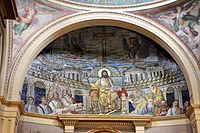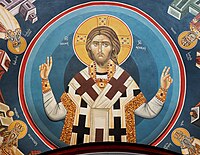Christ Pantocrator


InChristian iconography,Christ Pantocrator(Greek:Χριστὸς Παντοκράτωρ)[1]is a specificdepiction of Christ.PantocratororPantokrator,literallyruler of all,but usually translated as "Almighty" or "all-powerful", is derived from one of manynames of God in Judaism.
The Pantokrator is largely anEastern OrthodoxorEastern Catholictheological conception and is less common under that name inLatin Catholicism.In the West, the equivalent image in art is known asChrist in Majesty,which developed a rather differenticonography.Christ Pantocratorhas come to suggest Christ as a benevolent, though also stern and all-powerful, judge of humanity.
When theHebrew Biblewas translated into Greek as theSeptuagint,Pantokratorwas used both forYHWH Sabaoth(צבאות) "Lord of Hosts"[2]and forEl Shaddai"God Almighty".[3]In theNew Testament,Pantokratoris used once byPaul(2 Cor 6:18) and nine times in theBook of Revelation:1:8,4:8,11:17,15:3,16:7,16:14,19:6,19:15,and21:22.The references to God the Father and God the Son in Revelation are at times interchangeable, butPantokratorappears to be reserved for the Father except, perhaps, in1:8.
Meaning[edit]

The most common translation ofPantocratoris "Almighty" or "All-powerful". In this understanding,Pantokratoris a compound word formed from the Greek wordsπᾶς,pas(GENπαντόςpantos), i.e. "all"[4]andκράτος,kratos,i.e. "strength", "might", "power".[5]This is often understood in terms of potential power; i.e., ability to do anything,omnipotence.Christ pantocrator signifiesJesusin his glory during hissecond comingseated on histhrone.
Another, more literal translation is "Ruler of All" or, less literally, "Sustainer of the World". In this understanding, Pantokrator is a compound word formed from the Greek for "all" and the verb meaning "To accomplish something" or "to sustain something" (κρατεῖν,kratein). This translation speaks more to God's actual power; i.e., God does everything (as opposed to God can do everything).
Iconography[edit]

The icon of Christ Pantokrator is one of the most common religious images of Orthodox Christianity. Generally speaking, inByzantine artchurch art and architecture, aniconicmosaic or fresco of Christ Pantokrator occupies the space in the central dome of the church, in the half-dome of theapse,or on thenavevault. Some scholars (Latourette 1975: 572) consider the Pantocrator a Christian adaptation of images of Zeus, such as the greatstatue of Zeus enthroned at Olympia.The development of the earliest stages of the icon from Roman Imperial imagery is easier to trace.[8]
The image of Christ Pantocrator was one of the firstimages of Christdeveloped in theEarly Christian Churchand remains a central icon of theEastern Orthodox Church.In the half-length image, Christ holds theNew Testamentin his left hand and makes the gesture of teaching or ofblessingwith his right. The typical WesternChrist in Majestyis a full-length icon. In the earlyMiddle Ages,it usually presented Christ in amandorlaor other geometric frame, surrounded by theFour Evangelistsor their symbols.
The oldest known surviving exampleof the icon of Christ Pantocrator was painted inencausticon panel in the sixth or seventh century, and survived the period of destruction of images during theIconoclastic disputesthat twice racked the Eastern church, 726 to 787 and 814 to 842. It was preserved inSaint Catherine's Monastery,in the remote desert of theSinai.[9]Thegessoedpanel, finely painted using a wax medium on a wooden panel, had been coarsely overpainted around the face and hands at some time around the thirteenth century. When the overpainting was cleaned in 1962, the ancient image was revealed to be a very high-quality icon, probably produced inConstantinople.[10]
The icon, traditionally half-length when in asemi-dome,[11]which became adopted for panel icons also, depicts Christ fully frontal with a somewhat melancholy and stern aspect, with the right hand raised in blessing or, in the early encaustic panel at Saint Catherine's Monastery, the conventional rhetorical gesture that represents teaching. The left hand holds a closed book with a richly decorated cover featuring theCross,representing theGospels.An icon where Christ has an open book is called "Christ the Teacher", a variant of the Pantocrator. Christ is bearded, his brown hair centrally parted, and his head is surrounded by ahalo.The icon usually has agold groundcomparable to the gilded grounds ofByzantine mosaics.
Often, thename of Christis written on each side of the halo, asIC and XC.Christ's fingers are depicted in a pose that represents the letters IC, X and C, thereby making theChristogramICXC(for "Jesus Christ" ). The IC is composed of the Greek charactersiota(Ι) andlunate sigma(C; instead of Σ, ς)—the first and last letters of 'Jesus' in Greek (Ἰησοῦς); in XC the letters arechi(Χ) and again the lunate sigma—the first and last letters of 'Christ' in Greek (Χριστός).
In many cases, Christ has acruciform haloinscribed with the letters Ο Ω Ν, i.e.ὁ ὤν"He Who Is".
-
The Pantokrator on the HungarianHoly Crown,c. 1075
-
Pantocràtor de Taüll,Sant Climent de TaüllChurch,Catalonia.(Now at MNAC-Museu Nacional d'Art de Catalunya,Barcelona)
-
Christ Pantocrator mosaic from the dome of theChurch of the Holy SepulchreinJerusalem
-
Christ Pantocrator inside the dome ofChurch of the Saviour on the Blood(Храм Спаса на Крови),St. Petersburg
-
Mosaic ofPalatine ChapelinPalermo
-
Christ Pantocrator inside theSacred Heart Church (Berlin),c. 1900
-
A miniature Russian icon of Christ Pantocrator, richly decorated with pearls andenamel,c. 1899–1908
-
Damaged mosaic of Christ Pantocrator inside theKaiser Wilhelm Memorial Church,c. 1895
See also[edit]
- Christ the Redeemer
- Monumento al Divino Salvador del Mundo
- Salvator Mundi
- Transfiguration of Jesus
- Symbolism of domes
References[edit]
Footnotes[edit]
- ^παντοκράτωρ.Liddell, Henry George;Scott, Robert;A Greek–English Lexiconat thePerseus Project
- ^2 Kings(2 Samuel) 7:8 andAmos3:13
- ^Job5:17, 15:25 and 22:25
- ^πᾶς.Liddell, Henry George;Scott, Robert;A Greek–English Lexiconat thePerseus Project
- ^κράτος.Liddell, Henry George;Scott, Robert;A Greek–English Lexiconat thePerseus Project
- ^God's Human Face: The Christ-Iconby Christoph Schoenborn (1994)ISBN0-89870-514-2page 154
- ^Sinai and the Monastery of St. Catherineby John Galey (1986)ISBN977-424-118-5page 92
- ^Eduard Syndicus;Early Christian Art;pp. 96–99; Burns & Oates, London, 1962. Hall pp. 78–80; James Hall,A History of Ideas and Images in Italian Art,pp. 91–97, 1983, John Murray, London,ISBN0-7195-3971-4
- ^Manolis Chatzidakis and Gerry Walters, "An Encaustic Icon of Christ at Sinai",The Art Bulletin49.3 (September 1967) pp. 197–208.
- ^Galey, John, Forsyth, George, andWeitzmann, Kurt,Sinai and the Monastery of St. Catherine,p. 92, Doubleday, New York, 1980,ISBN0385171102
- ^Otherwise the size of the figure would have to be greatly reduced to avoid the head appearing at the flattening top of the semi-dome.
Bibliography[edit]
- Latourette, Kenneth Scott, 1975.A History of Christianity,Volume 1, "Beginnings to 1500". Revised edition. (San Francisco: HarperCollins)
- Christopher Schonborn, Lothar Kraugh (tr.) 1994.God's Human Face: The Christ Icon.Originally published asIcôn du Christ: Fondements théologiques élaborés entre le Ie et IIe Conciles de Nicée(Fribourg) 1976
Further reading[edit]
- Chatzidakis, Manolis (September 1967). "An Encaustic Icon of Christ at Sinai". Gerry Walters, tr.The Art Bulletin49.3, pp. 197–208.
- Galavaris, George (Jan 1, 1981).The Icon in the Life of the Church,11. Brill Academic Publishers.ISBN90-04-06402-8










